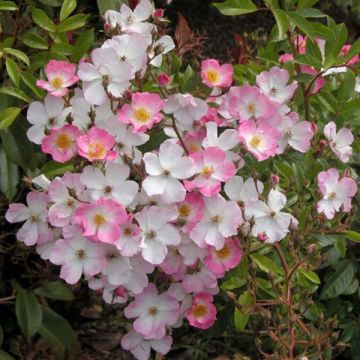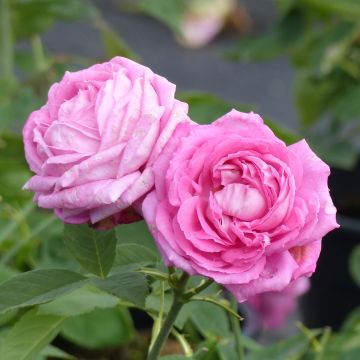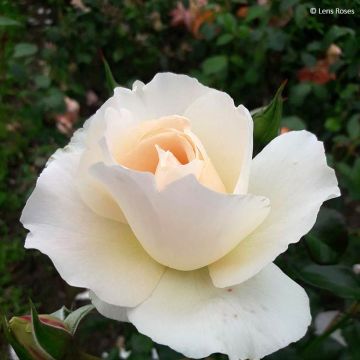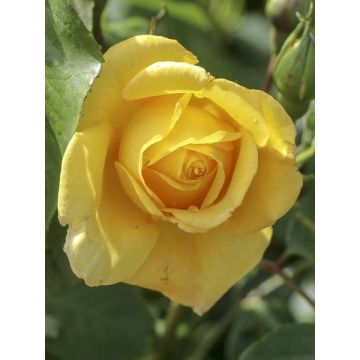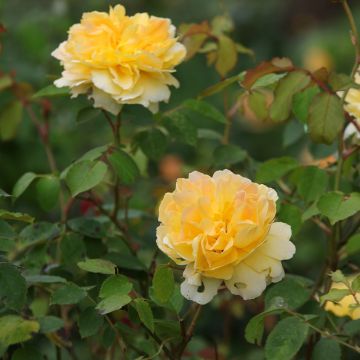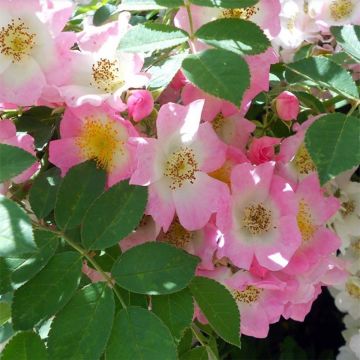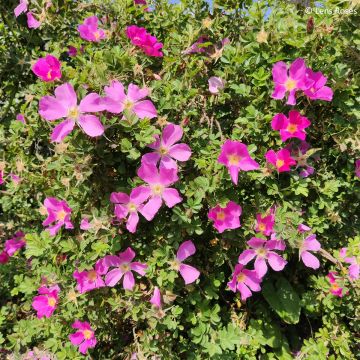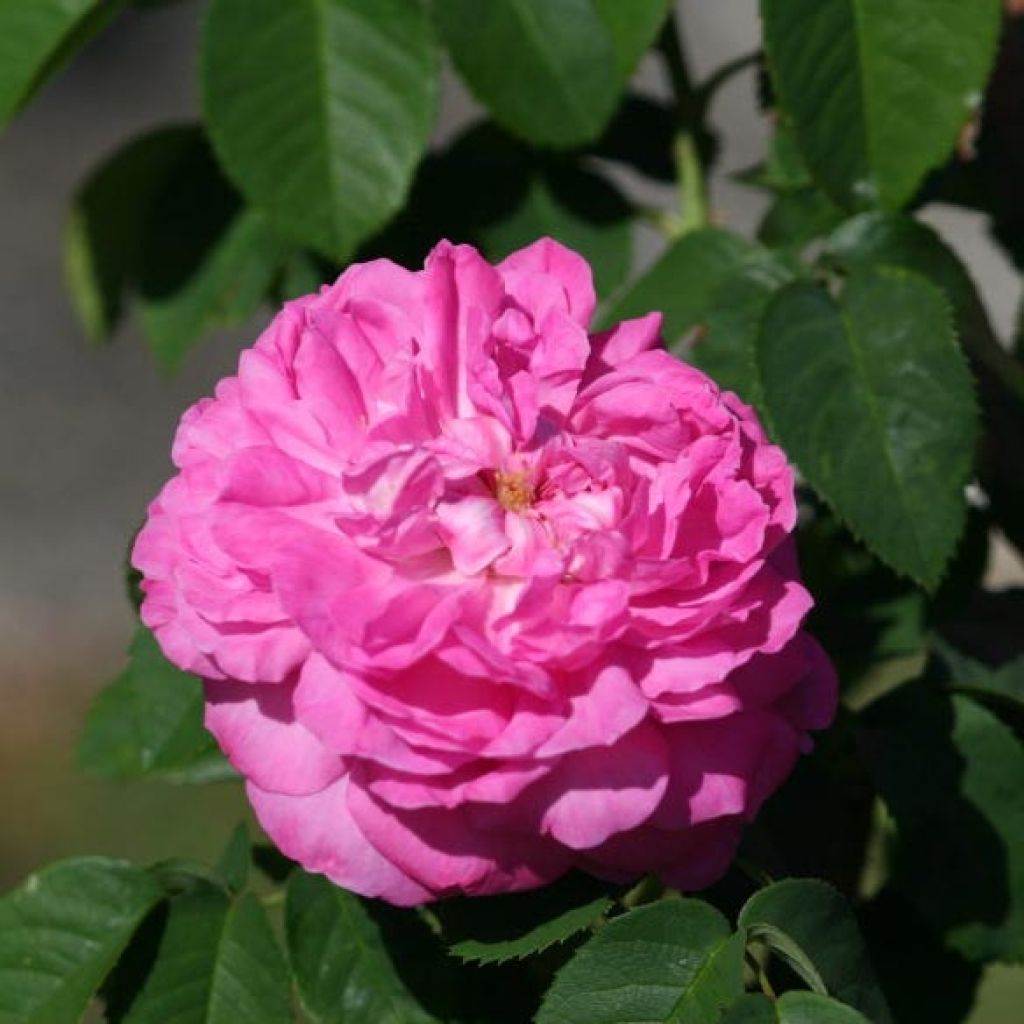

Rosa Baronne Prévost - Hybrid Perpetual rose
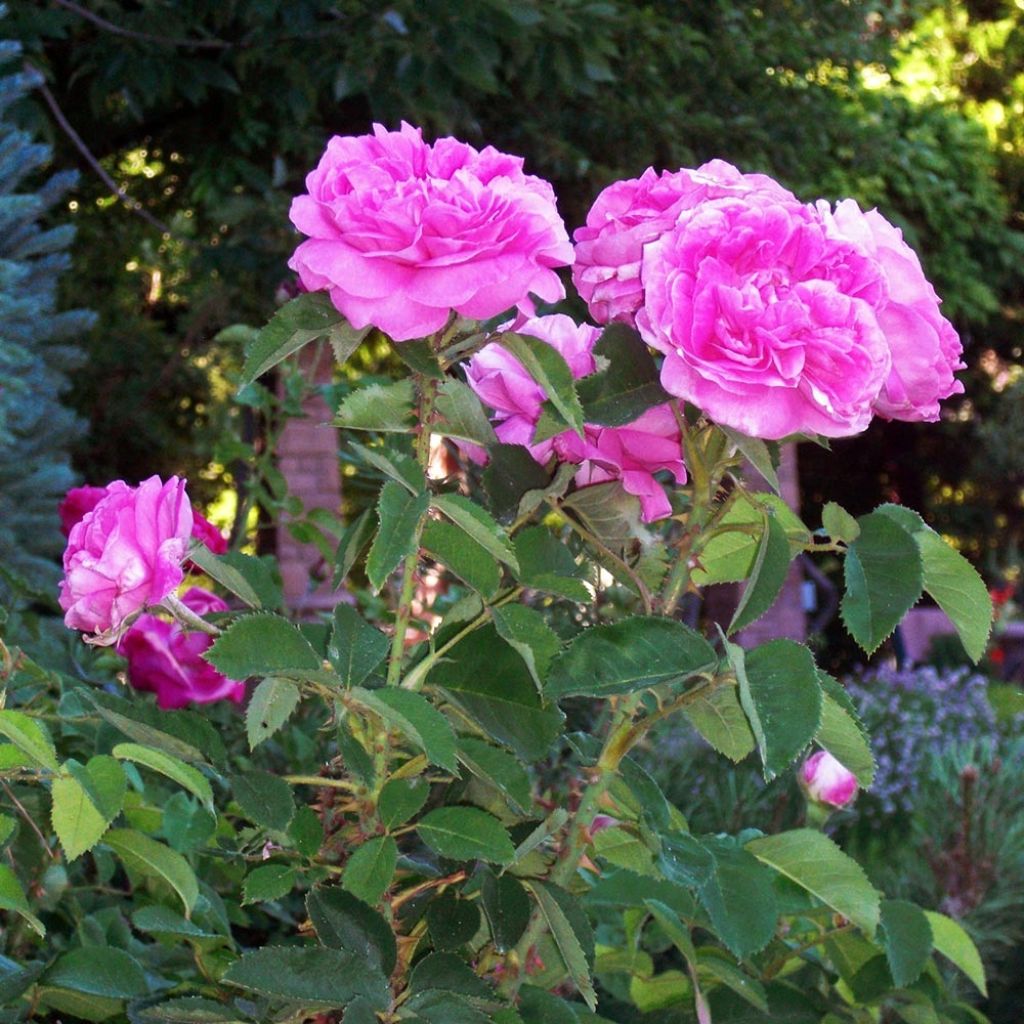

Rosa Baronne Prévost - Hybrid Perpetual rose
Rosa Baronne Prévost - Hybrid Perpetual rose
Rosa Baronne Prévost
Rosier Thé moderne
Received rose bush in very poor condition, branches broken and black spots on the leaves. I will not be ordering from this site again.
Lau, 13/06/2024
This item cannot be shipped to the selected country
Delivery charge from €5.90
Delivery charge from €5.90
Delivery to Corse prohibited
More information
Schedule delivery date,
and select date in basket
This plant carries a 24 months recovery warranty
More information
We guarantee the quality of our plants for a full growing cycle, and will replace at our expense any plant that fails to recover under normal climatic and planting conditions.
From €5.90 for pickup delivery and €6.90 for home delivery
Express home delivery from €8.90.
From €5.90 for pickup delivery and €6.90 for home delivery
Express home delivery from €8.90.
Delivery to Corse prohibited: UE law prohibits the import of this plant from mainland France to Corse as part of the fight against Xylella fastidiosa. Please accept our sincere apologies.
More information


Does this plant fit my garden?
Set up your Plantfit profile →
Description
Hybrid perpetual rose 'Baronne Prévost' is one of the first and best perpetual hybrids! Its refined flowers are classically shaped and nostalgically reminiscent of old roses. From June to November, this upright and thorny bush has large, upright flowers that are so double that the petals fold into quarters, in a rich pink tinged with lilac. They exude a powerful, wild fragrance. This vigorous and hardy shrub rose requires rich soil and a sunny exposure to flower again after its first abundant flowering in June. It is medium-sized and suitable for hedges and shrub borders.
The flowers of 'Baronne Prévost' Hybrid Perpetual Rose are exceptional with their numerous petals and quartered shape reminiscent of the double old roses. This pretty variety has a bushy, upright habit, whose stems have short, red thorns. It will reach about 150 cm (59in) high and 120 cm (47in) wide in a few years. The 11 cm (4in) very double, fragrant flowers, with flattened cup shapes divided into quarters, are generous, with 25 to 40 petals. They evolve from a rich pink tinged with lilac to mauve grey. They bloom in very large numbers, especially during their first flowering in June. This vigorous variety has beautiful, slightly satin-like, bright green foliage.
Bred by Desprez, France, 1841.
The 'Baronne Prévost' rose adapts to all soils that are not too dry, and all climates. However, it needs good exposure to the sun and rich soil to rebloom. It can be planted in groups of 3, arranged in a triangle, or as a solitary plant on a lawn. It will make a statement when planted en masse in the back of a flower bed or grouped between shrub borders, and it will fit perfectly with borders of light or opulent perennials with white, blue, pink, and violet flowers. For example, it can be planted with perennial geraniums (Geranium Blue Cloud, Anne Folkard, Nimbus, Orion), bellflowers (lactiflora, rapunculoides), catmints, perennial salvias, foxgloves, or other Stachys. When left to grow freely, it forms an upright shrub and can even be a small climber, trained against a support, creating a romantic backdrop behind a flower bed composed of abelias, Kolkwitzia, mock oranges, elderberries, Nandina, Choisya, shrubby artemisias, or many others.
Report an error about the product description
Rosa Baronne Prévost - Hybrid Perpetual rose in pictures
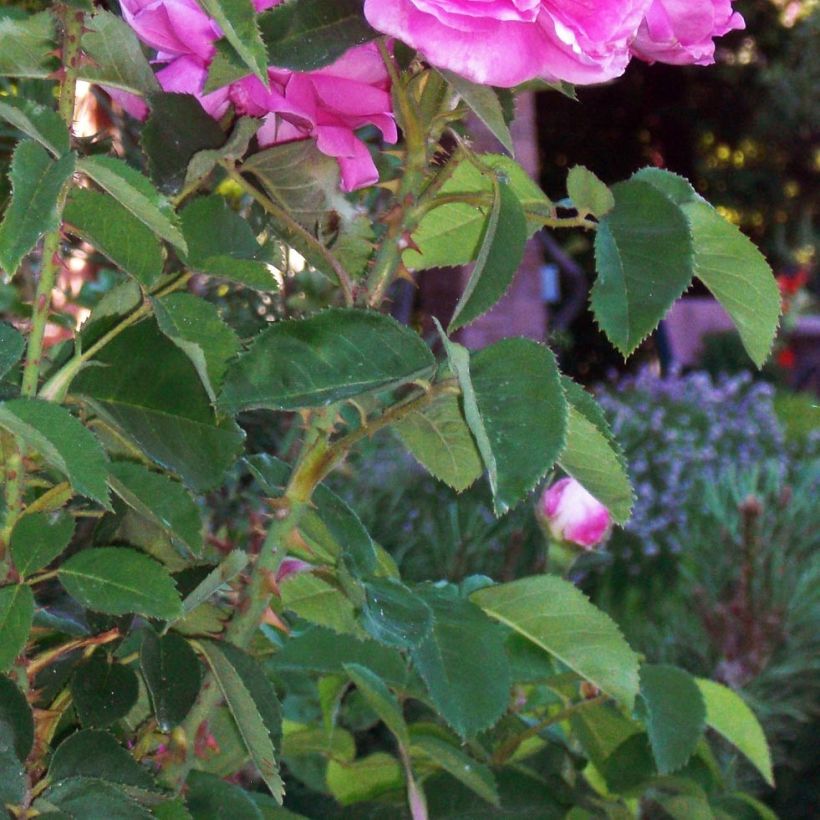

Plant habit
Flowering
Foliage
Botanical data
Rosa
Baronne Prévost
Rosaceae
Rosier Thé moderne
Cultivar or hybrid
Rosa canina Laxa (4L/5L pot)
Other Roses A to Z
Planting and care
Rose bushes prefer a sunny location (at least 4 to 5 hours of sunlight per day) but protected from burning midday rays and strong winds. Rose bushes like loose, well-draining soil that is rich in humus. They prefer slightly acidic soil but will adapt to any garden soil that is well-prepared and fertile. To plant your rose bush dig the soil to a depth of 25 cm (10in), breaking up the soil and adding a base fertiliser such as bonemeal. Remove your rose from its pot and position, covering the top of the root ball with 3 cm (1in) of soil, fill in the hole and water generously to eliminate any air pockets. During dry weather, regular watering is necessary for a few weeks to aid root establishment. Provide your rose bush with special rose fertiliser to stimulate flowering. To achieve abundant flowering of your climbing roses, regularly bend and tie the branches, that can grow up to 1 m (3ft) in a week during summer. Each bend will result in a lateral shoot that ends in a cluster of flowers. If you use this technique, you will be rewarded with lots of flowers.
Planting period
Intended location
Care
-
, onOrder confirmed
Reply from on Promesse de fleurs
Haven't found what you were looking for?
Hardiness is the lowest winter temperature a plant can endure without suffering serious damage or even dying. However, hardiness is affected by location (a sheltered area, such as a patio), protection (winter cover) and soil type (hardiness is improved by well-drained soil).

Photo Sharing Terms & Conditions
In order to encourage gardeners to interact and share their experiences, Promesse de fleurs offers various media enabling content to be uploaded onto its Site - in particular via the ‘Photo sharing’ module.
The User agrees to refrain from:
- Posting any content that is illegal, prejudicial, insulting, racist, inciteful to hatred, revisionist, contrary to public decency, that infringes on privacy or on the privacy rights of third parties, in particular the publicity rights of persons and goods, intellectual property rights, or the right to privacy.
- Submitting content on behalf of a third party;
- Impersonate the identity of a third party and/or publish any personal information about a third party;
In general, the User undertakes to refrain from any unethical behaviour.
All Content (in particular text, comments, files, images, photos, videos, creative works, etc.), which may be subject to property or intellectual property rights, image or other private rights, shall remain the property of the User, subject to the limited rights granted by the terms of the licence granted by Promesse de fleurs as stated below. Users are at liberty to publish or not to publish such Content on the Site, notably via the ‘Photo Sharing’ facility, and accept that this Content shall be made public and freely accessible, notably on the Internet.
Users further acknowledge, undertake to have ,and guarantee that they hold all necessary rights and permissions to publish such material on the Site, in particular with regard to the legislation in force pertaining to any privacy, property, intellectual property, image, or contractual rights, or rights of any other nature. By publishing such Content on the Site, Users acknowledge accepting full liability as publishers of the Content within the meaning of the law, and grant Promesse de fleurs, free of charge, an inclusive, worldwide licence for the said Content for the entire duration of its publication, including all reproduction, representation, up/downloading, displaying, performing, transmission, and storage rights.
Users also grant permission for their name to be linked to the Content and accept that this link may not always be made available.
By engaging in posting material, Users consent to their Content becoming automatically accessible on the Internet, in particular on other sites and/or blogs and/or web pages of the Promesse de fleurs site, including in particular social pages and the Promesse de fleurs catalogue.
Users may secure the removal of entrusted content free of charge by issuing a simple request via our contact form.
The flowering period indicated on our website applies to countries and regions located in USDA zone 8 (France, the United Kingdom, Ireland, the Netherlands, etc.)
It will vary according to where you live:
- In zones 9 to 10 (Italy, Spain, Greece, etc.), flowering will occur about 2 to 4 weeks earlier.
- In zones 6 to 7 (Germany, Poland, Slovenia, and lower mountainous regions), flowering will be delayed by 2 to 3 weeks.
- In zone 5 (Central Europe, Scandinavia), blooming will be delayed by 3 to 5 weeks.
In temperate climates, pruning of spring-flowering shrubs (forsythia, spireas, etc.) should be done just after flowering.
Pruning of summer-flowering shrubs (Indian Lilac, Perovskia, etc.) can be done in winter or spring.
In cold regions as well as with frost-sensitive plants, avoid pruning too early when severe frosts may still occur.
The planting period indicated on our website applies to countries and regions located in USDA zone 8 (France, United Kingdom, Ireland, Netherlands).
It will vary according to where you live:
- In Mediterranean zones (Marseille, Madrid, Milan, etc.), autumn and winter are the best planting periods.
- In continental zones (Strasbourg, Munich, Vienna, etc.), delay planting by 2 to 3 weeks in spring and bring it forward by 2 to 4 weeks in autumn.
- In mountainous regions (the Alps, Pyrenees, Carpathians, etc.), it is best to plant in late spring (May-June) or late summer (August-September).
The harvesting period indicated on our website applies to countries and regions in USDA zone 8 (France, England, Ireland, the Netherlands).
In colder areas (Scandinavia, Poland, Austria...) fruit and vegetable harvests are likely to be delayed by 3-4 weeks.
In warmer areas (Italy, Spain, Greece, etc.), harvesting will probably take place earlier, depending on weather conditions.
The sowing periods indicated on our website apply to countries and regions within USDA Zone 8 (France, UK, Ireland, Netherlands).
In colder areas (Scandinavia, Poland, Austria...), delay any outdoor sowing by 3-4 weeks, or sow under glass.
In warmer climes (Italy, Spain, Greece, etc.), bring outdoor sowing forward by a few weeks.




































